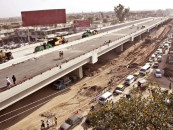The corridor that redrew the map
CPEC undermines New Delhi's vision of South Asia as its backyard

Power, once loud and territorial, now moves silently. It flows through undersea cables, over smart rail, beneath oil pipelines, and into the bloodstream of emerging economies. It wears no uniform, flies no flag. And today, it speaks Mandarin.
The latest flashpoint between India and Pakistan carried the weight of a message far beyond a routine skirmish; it signaled a shift. Because the real confrontation unfolded on a deeper plane, where commerce, infrastructure and digital routes now redraw the map of influence. And at the centre of that new cartography stands China.
When Indian Rafales took to the skies over contested territory, Pakistan answered with something unfamiliar: Chinese-made J-10Cs, armed with PL-15E missiles, long-range, radar-guided, and built for reach. Pakistan returned fire with precision, moving in concert with China, whose exported military ecosystem entered the arena, marking its arrival as a force rewriting the rules of engagement. Precision. Deterrence. Performance under pressure.
Analysts worldwide watched for what worked. The J-10C, long dismissed as a second-tier platform in defence circles, performed with surgical accuracy. Beijing's quiet confidence in its defence hardware was suddenly matched by proof. Pakistan had emerged as China's strategic partner as well as its showroom. Yet this confrontation in the clouds was only the surface of something deeper. The real battleground lies underfoot.
Beneath the dust of Balochistan and the waves off Gwadar, China is etching a new route into global power. The China-Pakistan Economic Corridor (CPEC) begins as a network of roads and ports, yet unfolds as China's bold reply to Western naval dominance. It provides Beijing direct access to the Arabian Sea, bypassing US-patrolled chokepoints. It allows Chinese goods to flow south through the Karakoram instead of east through contested straits.
It is Beijing's pivot from containment to connectivity.
And for India, this is the real incursion.
CPEC undermines New Delhi's vision of South Asia as its backyard. It rearranges the chessboard. And more dangerously, it proposes an alternative architecture, where power comes through partnership, not subjugation; through trade, not tanks.
This is the rise of China as a civilisational strategist.
Just as the West once built empires on railroads and gunboats, China builds corridors of steel, fiber, and credit. Where others sow dependence, it offers interdependence. Where others export chaos, it brings roads and routers. To many, especially those weary of IMF prescriptions, this is a different kind of proposition, one that doesn't ask for regime change, only right-of-way.
So when the Indian attacks came wrapped in counter-terror narratives, their true purpose was to stall this momentum. Disrupt logistics. Spook investors. Cloud the promise of a Pakistan aligned with China, rather than circling in the margins of colonial memory.
Rahul Gandhi said the quiet part aloud: that Pakistan-China alignment is a "crime" against India. But beneath the bluster was the real fear - that CPEC could work; that it could anchor Pakistan's economic autonomy; that it could succeed where Western partnerships had mostly produced crisis.
This is China's most subversive act: offering peace as power.
It doesn't march into capitals. It funds metros, ports, power plants. It embeds supply chains. Its method is quiet, its scale planetary.
CPEC is where that vision takes form. China's imprint achieved through connection rather than conquest. It signals Pakistan's shift toward Beijing's multipolar world. In this alignment, Pakistan emerges as a sovereign bridge between regions, no longer defined by subservience but by strategic geography, activated with intent and positioned for relevance.
And that logic is difficult to ignore.
China builds with choreography, each project a move in a larger, deliberate design. Its vision for Pakistan reaches beyond asphalt and steel. CPEC has already delivered energy projects that lit up once-dark cities, coal plants in Sahiwal and Port Qasim, hydropower stations in Khyber-Pakhtunkhwa, and solar fields in Bahawalpur. It connects Hazara through the Havelian-Thakot motorway, threads rail from Karachi to Peshawar, and transforms Gwadar with a deep-sea port, international airport and free trade zone. Plans include special economic zones in Rashakai and Dhabeji, industrial hubs meant to attract regional manufacturing. With fiber-optic cables stretching from Khunjerab to Rawalpindi, and a digital corridor in the making, China envisions a Pakistan that shapes flows of data, power, and influence.
China needs stable partners. And Pakistan, if it plays its cards right, can transform from periphery to pivot, so long as it chooses coherence over crisis.
But that choice demands a shift within.
Pakistan faces a reckoning with its addiction to short-termism. The time has come to align policy with vision, and governance with lasting continuity. Curricula need to evolve from rote memorisation to bold innovation. Universities should forge ties with Central Asian peers, creating networks of shared ambition. Trade diplomacy deserves its rightful place, as the spearhead of a new foreign policy. And youth must become more than an audience. They must be equipped as agents.
This is where China's model speaks loudest: think in decades, plan in corridors, build for permanence.
If Pakistan mirrors that thinking, offering venture capital for student start-ups, technical training in forgotten districts, fellowships in trade and climate, it builds more than infrastructure. It builds belief.
Of course, none of this will be smooth. Global volatility will test resolve. Delays will tempt despair. China's rise emerged through turbulence, carved in resilience, shaped by strategy, and driven with unrelenting purpose.
Pakistan, too, can choose that arc.
The old order will resist. It always does. CPEC moves cargo, and with it, ideas. It suggests that autonomy isn't the privilege of the powerful, but the prize of the prepared. It declares that smaller states can shape maps if they hold their course.
Today's sharpest borders are etched not in terrain, but in worldview. On one side: collaboration, connectivity, self-determined futures. On the other: coercion, chaos and manufactured instability.
Pakistan now stands at that border.
And how it steps forward will shape far more than its own map.















COMMENTS
Comments are moderated and generally will be posted if they are on-topic and not abusive.
For more information, please see our Comments FAQ